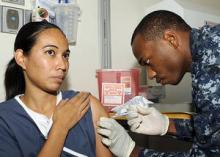Adult immunization rates in the United States are improving but very slowly, according to new data from the Centers for Disease Control and Prevention released on Nov. 17.
Overall, the 2009 National Health Interview Survey of 88,446 adults showed that adult immunization rates for influenza, hepatitis B, pertussis, and shingles increased by small proportions, compared with the previous year, while pneumococcal disease coverage dropped slightly. Moreover, large racial disparities persisted for influenza immunization, with lower proportions of African Americans and Hispanics receiving the vaccine than whites.
"We have wonderful vaccination rates in young children ... but there are lower vaccination rates in adults, and they show us that maybe we’re starting to take vaccines and immunity for granted. This is one area where we cannot rest on our laurels. Our accomplishments will be undone if we don’t maintain our immunity as adults," Dr. Susan J. Rehm, medical director of the National Foundation for Infectious Diseases (NFID), said in a press briefing.
The NFID, which cosponsored the briefing with the CDC, also released the findings from its survey of 300 primary care physicians and 1,013 American consumers aged 18 years and older, which showed a distinct communication disconnect: Whereas 90% of the physicians said they discuss vaccines with their patients, 47% of the patients couldn’t recall ever discussing vaccines other than influenza with their doctors, and one-fifth couldn’t recall discussing any vaccines.
However, nearly 9 in 10 patients said that a strong recommendation from a physician would be a very likely motivator for them to get vaccinated. "Overall I think these findings are in a way encouraging. Although we have this disconnect, we have a solvable problem, and that is communication. Patients need to hear the recommendation from their provider, and it needs to be clear," said Dr. Rehm of the Cleveland Clinic.
She added that because adults typically visit the doctor for an acute problem and not for routine medical care, "every adult visit needs to be an immunization visit."
Dr. Melinda Wharton, deputy director of the CDC’s National Center for Immunization and Respiratory Diseases, reviewed the data from the 2009 NHIS. For influenza vaccine, there was an overall 2.3 percentage point increase among adults aged 19-49 years during the 2008-2009 season, compared with 2007-2008. While the increase was even greater for African Americans, 3.6 percentage points, their overall influenza immunization rate was just 16.5%, compared with 21.6% among whites. The percentage among Hispanics in that age group was 14.5%, up by just 1.5 percentage points.
For ever-receipt of pneumococcal vaccine among those for whom it is recommended, coverage among adults aged 19-64 years in 2009 was 17.5%, a drop of 7.4 percentage points since 2008. This is likely due in part to the recent addition of smokers and asthma patients to the high-risk list, Dr. Wharton said, noting that coverage among adults aged 65 years and older remained stable, at about 61%.
Immunization against hepatitis B among those at risk increased to the greatest degree among African Americans, rose by 13.6 percentage points to 43.6%, similar to the 43.2% among whites. Herpes zoster vaccine, on the other hand, increased by just 3.3 percentage points, from 6.7% of adults aged 60 years and older in 2008 to 10.0% in 2009. In 2009, the proportion of women aged 19-26 years who received human papillomavirus vaccination was just 17.1%, up by 6.6 percentage points from 10.5% in 2008.
Data for pertussis – which is receiving increased attention now because of the California outbreak – is reported via tetanus coverage. In 2005, the CDC recommended that the then-newly licensed adult/adolescent formula tetanus-diphtheria-pertussis vaccine (Tdap) replace a single dose of Td vaccine for individuals aged 10-64 years. Of adults aged 19-64 years who received a tetanus vaccine since 2005 and knew which kind of vaccine they had received, only 50.8% reported receiving Tdap.
The NHIS data also included health care provider immunization rates, which showed an overall 7.1 percentage point increase in influenza immunization from 2007 to 2008 to 52.9% in 2008-2009, a 1.6 percentage point increase in the proportion of tetanus vaccination during 2005-2009 given as Tdap, to 58.3% in 2009, and a slight 0.5 percentage point rise in ever-receipt of three doses of hepatitis B vaccine, reaching 64.7% in 2009.
Dr. Rehm noted that 57% of physicians reported in the NFID survey that they didn’t have adequate time to discuss vaccination during hurried office visits. But, she said, "The immunization discussion doesn’t need to be long. It needs to be concise and clear. When I talk with my patients, I don’t say ‘I think you should consider the vaccine,’ and so on. I simply say I recommend that you receive this vaccine.’ Data show that patients are quite receptive to that, and look to their providers for that recommendation."


